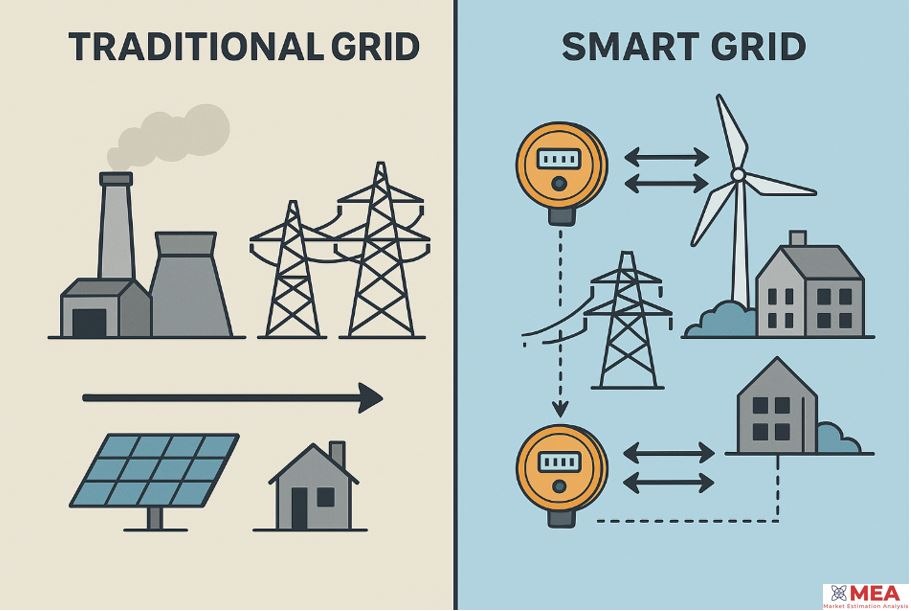Wired for the future: How smart grids are powering a new energy revolution?
Ready to discover how smart grids are powering a smarter, greener world? Click the dialogue box to dive into the latest technologies, global success stories, and the future of energy innovation that’s shaping tomorrow’s grid!
ENERGY AND POWER
4/12/20254 min read


For years, traditional power grids have worked in a simple way, electricity flows from big power plants to homes and businesses in one direction. But this old system has big problems. It is often unreliable, wastes energy, and struggles to handle modern needs like renewable energy. In places like the United States, the grid is aging, and with growing demand for power and a push for cleaner energy, it is under strain. As the world uses more electricity and focuses on sustainability, smart grids are stepping in. These advanced systems make electricity networks smarter, more efficient, and ready for the future. In this blog, we will dive into how smart grids are changing energy, the tech behind them, real examples from around the world, and what is ahead for this game-changing innovation.
What is a Smart Grid?
A smart grid is a modern electricity network that uses digital tools to watch and control energy flow in real time. Unlike the past, where power moved one-way, smart grids allow energy and information to flow back and forth between providers and users. This is made possible with tools like sensors to track performance, automated systems to boost efficiency, and communication networks to connect everyone. Key players include smart meters, part of advanced metering infrastructure (AMI), which show energy use instantly. This two-way setup helps everyone to make better choices about power, creating a more connected and flexible energy world.
Why the World Needs Smart Grids Now More Than Ever?
The need for smart grids is growing fast. As pet the recently published IEA report, electricity demand worldwide is set to grow nearly 4% annually through 2027, powered by surging usage across multiple industries. Experts predict it could rise in the future as populations grow and tech advances. Adding renewable energy, like solar and wind, is tricky because it is not always available, and old grids cannot manage it well. Climate change is also pushing us to cut carbon emissions, with goals to make most electricity renewable by 2050. Smart grids are the solution to handle these changes.
Key Features and Technologies Driving Smart Grids
Smart grids rely on cutting-edge tech to work their magic. Advanced Metering Infrastructure (AMI) is a big one, using smart meters, communication links, and data systems to track energy use live. This helps utilities avoid outages by alerting users to cut back during high demand. Demand response lets consumers adjust usage during peak times for rewards, lowering costs for everyone. Sensors across the grid provide real-time updates, acting like a nervous system to spot issues fast. Automation and distributed energy resources (DERs), like rooftop solar or batteries, add flexibility. Meanwhile, artificial intelligence and machine learning analyze data to predict problems, optimize power flow, and keep everything running smoothly.
Smart Grids in Action: Global Case Studies
Smart grids are already making a difference worldwide. In the U.S., the Pacific Northwest Smart Grid Demonstration involved over 60,000 customers, showing how detailed usage data and demand programs can ease peak loads and boost reliability. The Grid Resilience and Innovation Partnerships Program is investing up to $3.46 billion across 44 states to modernize grids. In Europe, the European Commission is pushing a digital energy plan, while Germany’s Energiewende plan uses smart tech to add more renewables. In Asia, China leads with big smart grid projects. Saudi Arabia is testing blockchain for clear energy trading under Vision 2030, and Singapore’s Smart Nation uses IoT to manage power better, inspiring other cities.
Benefits of Smart Grids
Smart grids bring big wins. They improve reliability with automated fixes that spot and solve outages quickly, keeping power flowing. They also save energy by showing real-time data to cut waste and fine-tune usage. Consumers get more control with insights from smart meters, helping them save on bills and support conservation. These grids make it easier to add renewable energy like solar or wind with smart forecasting and storage. Also, utilities save money with less manual work and better maintenance, which can mean lower costs for everyone.
Challenges and Barriers to Adoption
Despite the benefits, smart grids face hurdles. The upfront cost to install new tech and upgrade old systems is high, especially for smaller utilities. Cybersecurity is a worry too, as more connections mean more risks of attacks that could disrupt power or steal data. Rules and standards also lag behind, designed for old grids and not the smart ones. Moreover, many people do not know how smart grids help or trust new tech, needing education and incentives to get on board.
The Future Outlook: What’s Next for Smart Grids?
Smart grids are key to a cleaner future. They will help hit Net Zero goals by boosting renewable energy use, potentially cutting waste by 25% by 2030. They are also linking up with smart cities for better energy management. New tech like 5G, IoT, and blockchain will make grids smarter and safer, with faster monitoring and secure transactions. Global efforts, like the Mission Innovation Green Powered Future, are setting goals to handle 100% renewable energy by 2030. These steps will drive smart grids forward worldwide.
